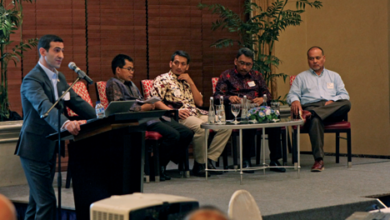By Alex Endress, Editorial Coordinator

Mel Whitby began his engineering career in 1968 in the field of scientific and optical instrument design and manufacture, such as microscopes. In 1972, he received his Certification in Scientific Optical Instrument Craft Production and Mechanical Engineering at the London City and Guilds.
However, it wasn’t until he moved to Houston in 1980 that he found his calling in the oil and gas industry. By 1982, he had joined Bowen Tools, designing and manufacturing downhole tools, workover equipment, BOPs and other pressure-control equipment. “When I started in oil and gas, it was on the back of the boom of the ’70s. It was a very tumultuous introduction into the business,” recalled Mr Whitby, who now serves as Director for Industry and Regulatory Business Affairs at Cameron, a Schlumberger company.
Within a few years of joining the company, Bowen had gone down to 935 employees from 2,700 in 1981. This mirrored the industrywide rig count, which had fallen by more than two-thirds, as well. Although times were tough, Mr Whitby said he decided to stay in the drilling business because he realized how much the world needed oil and gas. “I felt that it was worthwhile sticking with it because I knew oil and gas was going to be around no matter what,” he said. “I think it showed the mettle of a lot of people from that era, that they were willing to outlast the downturn.”
Many people didn’t survive the 1980s bust, however, and left the industry for good. Looking back at the generational gap that resulted from those times and looking at the current state of the industry, Mr Whitby said he hopes the same thing won’t happen again. “We have to be very careful when we’re treading this water,” he said. “The only substitute for 10 years of experience is 10 years of experience. Competency and capability are not necessarily the same things,” he said. Although a capable employee may have the ability to learn new skills, he explained, it takes experience in the field to develop true mastery of the skills.
The mass layoffs in the 1980s had also made it difficult to recruit young engineers because the industry gained “a negative connotation as being a hire-and-fire industry.” Yet, with technical innovations evolving as rapidly as they are now, he emphasized, it’s more important than ever that the industry not only keep its competent and experienced workers but also continue recruitment of fresh talent. For young engineers who may be concerned about the current economic environment and its impact on their careers, Mr Whitby reminds them that “there are always good times just as there are bad times” in this industry. If they persevere, they will have the chance to help build the next boom, just as many did after the last bust.
By 1996, Mr Whitby had joined Cameron as Director of Engineering, Research and Technology. In that position, he led the design of the 15,000-psi EVO BOP System, launched in 2007, and the development of the 18 ¾-in. 20,000-psi HP BOP, launched in 2009. The 20K BOP’s development was driven by demands from operators and drilling contractors for a lighter and smaller HP BOP that would retrofit to existing facilities, he said, adding that the ability to simplify will be critical to future BOP performance improvements.
“As any design evolves, you may run into a problem with complexity – because with complexity, reliability may also be impacted. You have to go back to the roots of BOP design and make designs simpler and more efficient, which subsequently can improve the reliability.”
In 2013, Mr Whitby moved into his current role in regulatory affairs, a transition that evolved out of his involvement with a multitude of post-Macondo efforts. Immediately following the event, he was assigned to Cameron’s Macondo response team, then participated in the US government’s forensic BOP investigation.
He also served on the drilling industry’s Joint Industry Task Force, which worked to strengthen guidelines for drilling procedures, well control and BOPs. Further, Mr Whitby served as Chairman of API Subcommittee 16, leading efforts to rewrite Recommended Practice 53, which became Standard 53 in November 2012. Pointing to S53 as what he considers one of the industry’s most notable achievements since April 2010, Mr Whitby noted that the standard “has become the baseline for a lot of the other improvements in both design specifications, operations and maintenance. I think that the drilling industry has done a lot to strengthen safety and reduce risk with practices that have been put in place by both IADC and by API, especially with respect to well construction, and the integration of capping stack technology and spill response.”
As the industry approached the sixth anniversary of Macondo, Mr Whitby urged companies to sustain their focus on continuous improvement despite the market downturn. Efforts such as the second edition of the IADC Deepwater Well Control Guidelines, to which Mr Whitby contributed, must continue in order to keep raising the bar for well control and drilling operations, he said.
The new guidelines, which were launched last year, also incorporate well control considerations for technologies such as managed pressure drilling and underbalanced drilling that weren’t in play when the first edition was released back in 1998. “All of that needed to be incorporated in the guidelines to establish a baseline of operation and well control of the processes.” DC
Click here to view DC’s virtual panel discussion on API Standard 53.





Our industry needs to listen more to these people, like Mel, who have been out to the oil fields to see their equipment work, instead of simply listening to the people with advanced degrees and certificates behind their names. Nothing replaces hands on experience and talking to our drillers face-to-face.